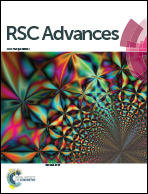Lanthanide complex-incorporated periodic mesoporous organosilica nanospheres with tunable photoluminescence†
Abstract
A series of nanoscale periodic mesoporous organosilica spheres (PMOSs) have been synthesized via the co-condensation of N,N-bis(trimethoxysilylpropyl)-2,6-pyridine dicarboxamide (DPA-Si) and tetraethyl orthosilicate (TEOS) in the presence of the surfactant hexadecyltrimethylammonium bromide (CTAB) under alkaline conditions. All PMOSs were characterized by FT-IR and solid state 13C and 29Si MAS NMR spectroscopy, powder X-ray diffraction (PXRD) as well as nitrogen physisorption, confirming the successful incorporation of the bridging functional organic DPA moieties and the formation of ordered mesostructures. Scanning electron microscopy (SEM) and transmission electron microscopy (TEM) revealed a spherical morphology (diameter ca. 70 nm) and ordered structures of the PMOSs. Incorporation of Eu(III) or Tb(III) ions into the PMOS frameworks by coordination to the DPA “ligands” generated lanthanide-hybrid PMOS with tunable photoluminescent properties that could make them promising candidates for applications in optical devices.


 Please wait while we load your content...
Please wait while we load your content...